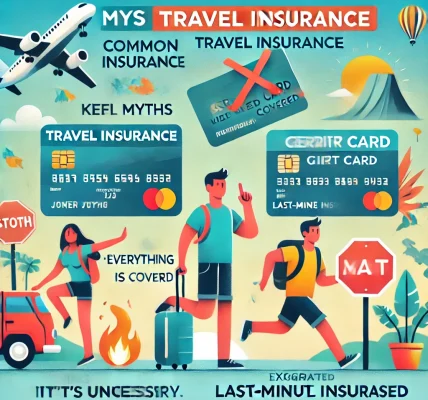Introduction
Adventure sports enthusiasts know that the thrill of activities like skydiving, scuba diving, skiing, and mountain biking comes with an element of risk. Whether you’re scaling high peaks or diving into the deep sea, accidents can happen, making travel insurance essential.
However, not all travel insurance policies automatically cover adventure sports. Many standard policies exclude high-risk activities, requiring additional coverage or special policies tailored for extreme sports. Understanding what is and isn’t covered can help you select the best travel insurance plan for your adventure-filled trip.
In this guide, we’ll break down the essential aspects of travel insurance for adventure sports, what’s covered, what’s not, and how to choose the right policy.
Why Do You Need Travel Insurance for Adventure Sports?
Adventure sports involve a higher level of risk compared to regular travel activities. Here’s why having specialized travel insurance is crucial:
- Medical Emergencies: Injuries from extreme sports can lead to expensive hospital bills, especially if medical evacuation is required.
- Emergency Evacuations: If you need an airlift from a remote mountain or deep-sea location, evacuation costs can be astronomical.
- Trip Cancellations or Interruptions: Unforeseen injuries may force you to cancel pre-booked activities, leading to financial losses.
- Equipment Loss or Damage: Many adventure activities require expensive gear, which may be covered under the right insurance plan.
- Peace of Mind: Having coverage allows you to focus on enjoying your trip without worrying about unexpected medical bills or logistical nightmares.
What Adventure Sports Are Typically Covered?
Insurance providers often classify adventure sports based on risk levels. Some common activities covered under adventure sports insurance include:
Commonly Covered Sports (Low-to-Moderate Risk)
- Snorkeling
- Trekking (up to a certain altitude)
- Kayaking
- Surfing
- Cycling
- Horseback riding
- Hot air ballooning
Sports Requiring Additional Coverage (Moderate-to-High Risk)
- Scuba diving (beyond a certain depth, usually 30m+)
- Mountain climbing (above a specific altitude, typically 3,000m+)
- Skiing & Snowboarding (off-piste or without a guide)
- Skydiving
- Whitewater rafting (Class IV or higher)
- Paragliding
- Bungee jumping
Always check your policy details, as some insurers may require you to purchase a special rider (add-on) for these high-risk activities.
What’s Covered in Adventure Sports Travel Insurance?
While coverage varies across insurers, a comprehensive adventure sports policy generally includes:
1. Medical Expenses
- Covers treatment costs for injuries sustained during the covered activities.
- Includes doctor consultations, hospitalization, surgery, and medications.
2. Emergency Medical Evacuation & Repatriation
- Covers evacuation from remote or inaccessible locations to the nearest medical facility.
- Includes repatriation (transporting you back home for medical treatment if necessary).
3. Trip Cancellation & Interruption
- Refunds prepaid expenses if you are unable to participate due to injury or illness.
- Covers trip interruptions due to medical emergencies.
4. Personal Liability Coverage
- Protects you in case you accidentally injure someone else or damage property while participating in an adventure activity.
5. Lost or Damaged Sports Equipment
- Some policies cover loss or damage to rented or personal adventure gear (e.g., ski equipment, diving gear, mountain bikes).
What’s NOT Covered? Common Exclusions
Many adventure travel insurance policies come with exclusions. Here are some scenarios where your claim may be denied:
- Participating in Extreme or Unapproved Activities: Some sports, such as base jumping or freestyle skiing, may not be covered under any policy.
- Lack of Proper Certification: If you scuba dive without a valid PADI certification, your claim may be denied.
- Competing in Professional or Organized Sports Events: Most insurers don’t cover injuries sustained during competitive events.
- Negligence or Reckless Behavior: Injuries caused by ignoring safety protocols, consuming alcohol, or engaging in illegal activities are not covered.
- Failure to Wear Protective Gear: If you don’t use a helmet or safety equipment, insurers may deny your claim.
- Medical Conditions Not Disclosed: If you have a pre-existing condition that affects your ability to participate safely, it may not be covered.
How to Choose the Best Travel Insurance for Adventure Sports
1. Identify the Activities You Plan to Do
- Make a list of all planned adventure sports and check whether they are covered.
2. Look for Comprehensive Medical & Evacuation Coverage
- Choose a policy that includes at least $100,000 in medical coverage.
- Ensure emergency evacuation is covered, especially for remote destinations.
3. Check for Activity-Specific Exclusions
- Read the fine print carefully to confirm if any of your planned activities are excluded.
4. Consider Gear Coverage
- If traveling with expensive sports equipment, ensure coverage for theft or damage.
5. Review the Claims Process
- Look for insurers with an easy claims process and 24/7 customer support.
6. Compare Policies from Different Insurers
- Check reviews and compare pricing, coverage, and exclusions before purchasing.
Steps to Take if You Have an Adventure Sports-Related Emergency
If you get injured while participating in an adventure sport, follow these steps:
- Seek Immediate Medical Attention: Visit the nearest hospital or clinic.
- Contact Your Insurer ASAP: Report your situation and get approval for coverage if needed.
- Document Everything: Keep medical bills, hospital reports, and any incident reports.
- Follow Up on Your Claim: Submit necessary documents and stay in touch with the insurance provider.
Conclusion
Adventure sports bring excitement and adrenaline, but they also come with risks. Having the right travel insurance ensures financial protection in case of injuries, evacuations, or trip disruptions.
When choosing a policy, carefully review what activities are covered, medical expense limits, and exclusions. A well-planned adventure is a safe adventure—make sure your travel insurance matches your thrill-seeking lifestyle.




